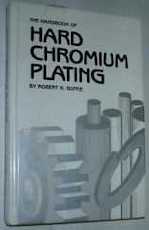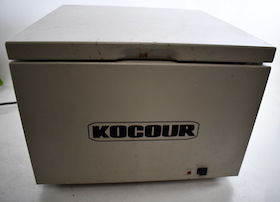
-----
Chrome Plating Required Tank Size
Q. I am looking for information regarding the design of chrome plating tanks. Specifically, I would like to know if there is either a table or a formula that I can use to determine the tank size needed for a given surface area to be plated.
John L. Zable1997
A. Having recently been bloodied in one of finishing.com's chats, I offer this again: I believe that each plating solution has a practical limit measured in amperes/gallon. For cadmium cyanide, I think it is around 3 amps/gallon. I will take a guess at hard chrome: Since it may very well be plated at 150 ASF, I will say 5 x 3 = 15 amperes/gallon. (Duck!) for the answer.

Tom Pullizzi
Falls Township, Pennsylvania
A. John,
I approach the problem of tank size from the opposite direction that Tom does. In my opinion, it must fit in the tank in a manner appropriate for that type of plating. The first question for chrome plating is tank anodes or conforming anodes and the distance of the anode from the part. Tighter spacing allows more of the amperage to go to plating and uses a lower applied voltage, so less heat and gas is generated.
With conforming anodes, 2 ASI is a practical minimum and 4 ASI is a PRACTICAL maximum for most. Much higher is possible. Shape of your part is going to drive ASI also. A lightly loaded tank does not need cooling. A heavily loaded tank needs lots of cooling. This takes up tank space. I seriously doubt if many companies only plate one or two parts. I suspect that your company plates tiny areas on huge parts occasionally which negates all theoretical work.
Summary: Part size, shape, racking methods, anode design and practical operation is going to drive tank design more than any theoretical Amps per Gal ever will.
An opinion of a hands-on plater.
James Watts- Navarre, Florida
Q. This question arose from a problem with a supplier that chrome plates a lot of small parts. Extremely large adds of chromic acid are being made on a weekly basis. The original concern of the supplier was that they were unable to control the sulphate in the bath.
After discussing the situation more fully with our field representative it was determined that the tank was undersized for the amount of surface area being plated. While I am waiting for the field representative to provide me with the chemical history of the tank, I was asked how large their tank should be. Based on the limited information that I had, I gave my best estimate that either the size of the tank needed to be increased by a factor of 2 to 3 or that 2 to 3 more tanks of the same size should be added to the line, both costly solutions. This would, however, reduce the size, as well as the impact on the tank chemistry, of the weekly additions of chromic acid to 1/2 to 1/3 the current weekly addition, which would reduce rate of sulphate increase by a similar factor. I told the field representative that I would get back to him either when I had a better answer or after I looked at the tank chemistry records, at which time I would base my conclusions on minimizing the effects of the additions of chromic acid.
I have always believed, as does Tom, that there is a practical limit to the surface area that can be plated in a solution that can either be measured, as he does, in amperes per gallon or in square inches per gallon. One can always convert from one to the other using the average amperes per square inch. I believe that an element related to time should be added to the equation, though, such as how many square feet per gallon per month can be plated in a solution. It is this belief that sparked me to ask this question.
John L. Zable [returning]A. I don't want to minimize the concern of maintaining the proper chromic acid/sulphate ratio, but maintaining the proper ratio should not be any more a problem than maintaining the proper chromic acid content.... unless sulphate is being dragged in from another process.
Or a problem related by the following (SRHS means Self Regulated High Speed):
FROM A COLUMN CALLED "Misplates"

Chrome platers confess, before SRHS
They were fit for the state sanitarium.
If the ratio was high, some sulphate they'd try,
And if it was low they'd add barium.
Back several years, one of our engineers
Was calling on chrome plating plants.
He got past the doorman, and saw the day foreman,
Who whispered with quick sideways glance:
"When the foreman at night, has gone out of sight
I put sulphate in without waitin'.
I keep him a-goin', without him a-knowin',
He's not so good at chrome platin'."
After getting a bite, he went back that night
For some reason inconsequential.
The night foreman spied him, came over beside him,
And murmured in tones confidential:
"When the foreman by day, has gone on his way,
The first thing I do is add barium.
When it comes to chrome, he's weak in the dome,
It's a good thing he's got me to carry 'im!"
-- I don't know who wrote this; if someone knows, please tell us.

Tom Pullizzi
Falls Township, Pennsylvania
A. Bob Guffie's book "Hard Chromium Plating" on pages 44 - 47 details the sizing of a chromium plating tank, far too extensive to write here..
and
Tom, I don't know if this is the column you were referring to, but the one above was written by V.E Guernsey (another former M & T'er). The above article appeared in the January, 1985 issue of Metal Finishing. It was the third part of a series written by Vee and the series was called -Down where the Chrome Don't Go-.

Ken Lemke
Burlington, Ontario, Canada
Ken, I believe you are right about the author, but I think the poetry precedes 1985; I think Walter Pike gave me a copy of it, and I left M & T in 1984. Thank you,

Tom Pullizzi
Falls Township, Pennsylvania
Editor's note: We subsequently found out from V.E. Guernsey that J.M.Hosdowich was the author of the poem. V.E. sent us a booklet called "Misplates", with this and all the Hosdowich poems, and Atotech gave us permission to serve it here.
A. Hi John,
Tank size is not the problem. If a weekly analysis in inadequate, that person should be on a two times a week, or every other work day cycle. He could put in a tank that is a thousand times bigger and only test it on an annual basis. Common sense or simple logic must prevail. Tank size and work load should dictate analysis schedule, not analysis schedule dictating tank size.
Baumé is a fair indicator of chromic acid when correlated to lab analysis.Vendor provided data did not work for me. Trivalent effects it considerably. Kokour sulphate test is fairly quick and more than accurate enough when done properly.
It is a lot cheaper to increase analysis to an appropriate level than it is to change a line.
Sulphate will fluctuate some, but if it is violent, the analysis is not done correctly or someone is "helping" as in Tom's poem.
Because the major OEM's have huge tanks, they have established a commonly used weekly testing cycle. It is obviously inadequate for the referenced individual. Most platers would love to have that persons problem, large thruput out of a small line.
At a last resort, they could add chromic acid on a daily basis based on history of the number of parts processed. sulphate is not used. Its loss is from dragout. If the catch rinse is plowed back into the plating tank, on a sometimes basis, but not always, his sulphate could vary wildly.
A month of excellent records and daily analysis could provide a data base for arbitrary adds without analysis that would not be labor intensive and would maintain the tank in a nearly level, optimum state. I do have my doubts if they would keep enough quality records or they would have been analysing on a more frequent basis on their own.
James Watts- Navarre, Florida
by Robert K. Guffie

on eBay (rarely) or Amazon (pricey)
or AbeBooks (rarely)
(affil link)
Q. I would like to thank Ken for the reference, I had overlooked that book during my initial search. In Guffie's book, he recommends an amperage to volume ratio of 0.25 amperes/gallon, which is the only information which interested me. It is nice to know that he agrees with Tom and me that the volume of the tank should be based on amperage.
The problems that the vendor is having deal with the large adds of chromic acid that are made on a weekly basis, as I mentioned before. The chromic acid concentration is fluctuating between the specification maximum and minimum on a weekly basis. Since sulphate is an impurity in almost all chromic acid, a significant increase in the sulphate concentration, which correlates with the additions of chromic acid, is seen in the data. The vendor can only increase the analysis frequency to twice a week since the gravimetric method is used for sulphate analysis. We currently do not allow the use of the centrifuge method for sulphate analysis and the vendor does not have other analytical instrumentation available.
While I agree that analysis frequency should be determined by production experience, I believe that analyzing a tank more than once a week is a bit excessive. If experience shows that the tank needs to be analyzed more frequently, either the process is not robust or the tank is undersized. We, as an OEM, specify that the frequency of analysis of chrome plating tanks be determined by production experience with the exception that our Class 3 process requires chromic acid and sulphate to be determined at least weekly.
In this case, however, even if the analysis frequency were increased, the sulphate concentration would still continue to increase at the same rate. This would still require either frequent draw-offs or transfers to another tank for barium carbonate treatment. We do not allow barium carbonate treatment to be performed in situ. Based on all of the information presented here, my assessment is still that the tank is undersized for the amount of work being processed.
Dr. John L. Zable [returning]A. Interesting, but I'm still with Jim on this one. Amps/gallon and similar ratios should be mere guidelines that suggest the general vicinity of a crossover point where it might start becoming more practical to go with two smaller tanks than to go with oversized cooling coils, large bus bars and customized saddles, special rectifiers, and so on.
The situation here seems to be that the only factor suggesting that two tanks are a more desirable situation is the frequency of analysis and adds. If you put two tanks in, you've doubled the frequency of analysis and adds anyway. Like Jim, I would get that tank under control, and only then look at the economics of a second tank as a means of reducing analysis costs and interruptions.
As Jim suggests, and as Tom has suggested under other circumstances, additions need not be confined confine to what has been analyzed for this minute; the analysis can also be used to support smaller, more frequent, "blind" adds. For example, if analysis every Friday shows that you always need to add 100 pounds, then you can safely add 50 pounds on Wednesday without waiting for an analysis. And if the data is convincing enough, you can add 20 pounds a day. Just another opinion.

Ted Mooney, P.E.
Striving to live Aloha
finishing.com - Pine Beach, New Jersey
Ted is available for instant help
or longer-term assistance.
A. Hi John,
As always, when there is more information, it is easier to answer a question.
Here, it would appear that tank size is not the problem, it is the growth of sulphate. If his tank were 4 times larger, eventually he would have excessive sulphate. It would take longer to get there, but the problem would be 4 times larger when it arrived.
Sulphate is very probably coming from other sources as well as the sulphate in the chromic acid. Are they using a sulphate based acid for activation? Are they using DI water for make up and water replenishment. Are they using the catch rinse for the water loss make up and if so, does it get DI water. The chromic acid that I have used from two sources had a very low amount of sulphate.
A daily Kokour sulphate is better than no sulphate testing or once a week gravimetric, especially when using an electric centrifuge and correlated to gravimetric analysis by that lab.
Chromic acid adds that go from minimum to maximum once a week are going to have wild ratio changes which is going to affect the plating rate. I would at least do a twice a week analysis for chrome at a minimum and more often if my additions were over 3 oz per gal of chromate.
A side tank with barium and filtration for the solution or a selective DI resin to remove sulphate from the plowback rinse solution will keep the sulphate in check at a moderate cost.
Amps per gal is, at absolute best, a starting point on design. Real life, daily operation, will establish allowable loads and frequency of analysis.
The shop needs to solve its source of sulphate and take appropriate counter measures. If daily analysis is required, and he can not do it, he should look at a part time college student of lab tech full time to do the analysis.Saying that there is not enough time is about one of the lamest excuses I have heard of. If they would take care of there source problem, analysis would not be such a demand.
As I said in an earlier response, most platers would love to have so much work go thru their tanks that they had to analyze on a daily basis.
James Watts- Navarre, Florida
A. Mr. Guffie's book, I believe suggest 4 amperes/gallon, and that is to prevent overheating. The reason my estimate of 15 amperes/gallon was wrong, I can see in hindsight, is that a 1 or 2 degree rise in the temperature of a cadmium cyanide solution won't make much difference, while in hard chrome plating, it is critical to bright range and current efficiency.
A nice reference book to have around.

Tom Pullizzi
Falls Township, Pennsylvania
Response to Tom's comment:
I have run 185 amps in a two gal pilot plant unit with a cooler unit to maintain temp at the desired point. Have run 400 amps on a 50 gal tank or 8 amps per gal with no chiller and no temp change using tight anode spacing and conforming anodes. I doubt if it would work on a tank anode operation. Still do not believe that amps per gal is a valid approach until all of the specific conditions are stated and that makes it so awkward that it is useless. It still boils down to what load you can get in the tank on a continuing operational basis and square inches or square feet will drive the amperage and efficiency will determine if cooling is required.
James Watts- Navarre, Florida
by Robert K. Guffie

on eBay (rarely) or Amazon (pricey)
or AbeBooks (rarely)
(affil link)
[editor appended this entry to this thread which already addresses it in lieu of spawning a duplicative thread]
Q. Hi. Can the volume of the tank for the hard chroming have any influence on the proper chroming process? We use ChromKlad 2500; 3,3 ASI at 140 °F. We are chroming the inside diameter .236" in the length 14.5" in the vertical position under the usage of the lead anode with the diameter 0.077". According to the Guffie book.
should our tank be 3 times smaller or we should chrome 3 times higher quantity of the parts. The biggest difference is in the depth of the tank - ours is 59" deep and there is not applied any kind of the forced circulation or mixing. I am afraid that the big space between the end of the part and the bottom can cause the problems in the quality of the chromed layer.
- Plzen, Czech Republic
April 9, 2015
A. Hi, Plzen
Chrome tank anode should be slightly shorter than cathode; if anode is longer than cathode you have build up problem.

Popatbhai B. Patel
electroplating consultant - Roseville, Michigan
Q, A, or Comment on THIS thread -or- Start a NEW Thread
